[ 149 ]
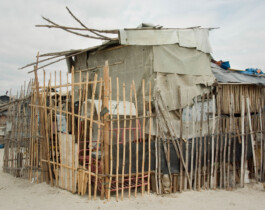
1
Peter Bialobrzeski (DE),
Case Study Homes
Manila, Philippines
Reflecting socioeconomic realities
Peter Bialobrzeski's series Case Study Homes was created in February 2008 in Baseco (The Bataan Shipyard Corporation Compound), a squatter camp located at the mouth of the Pasig River near the port of Manila. In this neighborhood, built on unstable ground of a former landfill, currently around 70,000 people live on 300 hectares. Approximately 45 percent of the over 11 million people in the Metro Manila region live in squatter camps and slums.
The images resulting from this photographic research follow a strict composition. Huts built by the residents themselves from old slats and posts, tarps, roofing felt, corrugated iron, and various fabrics fill each image in such a way that each individual house is captured as completely as possible, almost as if it were being portrayed. In many cases, the photographer chose a perspective from slightly in front; in this way, you can see the front and one side wall of the house. Strict frontal views and shots of two or more houses are rather rare. The soft natural light of the cloudy sky creates even illumination without strong light and shadow contrasts [1]. People are rarely seen at the edges of the images. (There is one exception, where a smiling resident sits in the doorway of his hut, allowing one to gauge the size, or rather smallness, of the building. However, he is only discovered on closer inspection.)
The Dichotomy of Bialobrezeski’ Images
Bialobrzeski’s approach in Case Study Homes is reminiscent of the photographic series by Bernd and Hilla Becher, who created paradigmatic works on the typology of «nomadic architecture,» especially of industrial buildings. However, Bialobrzeski counteracts the Bechers' deliberately objective position in several respects. Firstly, the theme itself—the hut built from found materials—defies the law of series or type. The houses have an anarchic, pirate-like, improvised appearance. The rule that certain features beyond the roof and walls must be present in a typical Baseco house does not exist. The builder-residents each find individual solutions for constructing their shelters from seemingly worthless waste. A certain role is apparently played by the frame and post construction method, which is common in traditional Asian huts. Additionally, Bialobrzeski photographs in color here, as in all his series. In their colorful and diverse nature, often created using colored tarps or old advertising banners, the makeshift shelters transform into works of art in the eyes of the Western viewer following the principle of collage. Despite this artistic appearance, which is also due to the staging of the images, it is never forgotten for a moment that they document the living conditions of many people [2]. A similar experience is had by viewers of Bialobrzeski’s earlier series. The artistic compositions and the use of color make the images of Asian megacities from the ↘︎ Neontigers series highly attractive to the eye; the reality of life they document appears daunting to many. In Bialobrzeski’s oeuvre, which has been developing since 1997, Case Study Homes behaves complementarily to the series Neontigers (2000-2002) and ↘︎ Lost in Transition (2004-2005), but also to the nostalgic images from the ↘︎ Heimat series (2002-2005) [3].
BASECO vs. LOS ANGELES' Modern Housing
The title Case Study Homes refers to the Case Study House Program, initiated in 1945 by John Entenza, editor and publisher of the magazine Arts and Architecture, which is now considered one of America's most significant contributions to modern architecture of the 20th century. The program aimed to develop modern single-family homes that could be built from inexpensive materials. Architects such as Richard Neutra, Charles and Ray Eames, and Raphael Soriano were involved; Julius Shulman's photographs of these housing icons also contributed to anchoring them in the collective memory of modernity. However, living according to the model of the houses in Baseco/Manila is undoubtedly more binding for many more people than that of modern homes around Los Angeles.
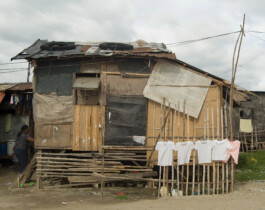
2 Baseco is a kind of «Ellis Island» for the labor migrants leaving the Philippine province in hopes of a better life. The buildings situated directly on the beach resemble fishing huts; however, the materials are not self-cut wood, but rather what is discarded by the city: campaign posters, Euro pallets, driftwood.

3

4
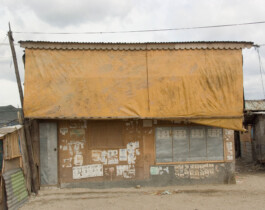
5

6

7

8
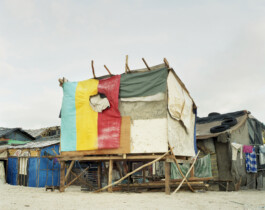
9
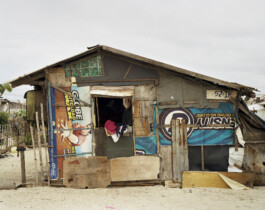
10
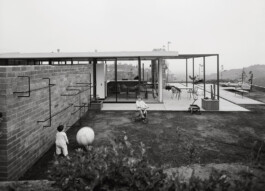
11 The Craig Ellwood house, constituting a prime example of mid-century modern architecture, featured a steel construction and open-plan layouts, embodying the ethos of the Case Study House Program.
Notes
[1] Cf., Case Studies. Peter Bialobrzeski und Oliver Boberg (n.d.), L.A. Galerie Lothar Albrecht, ↘︎ https://lagalerie.de/Case%20Studies%20DE.pdf [accessed February 26, 2024].
[2] Cf., Peter Bialobrzeski, «Peter Bialobrzeski: ‹Case Study Homes›», Neue Züricher Zeitung, September 23, 2009, ↘︎ https://www.nzz.ch/peter_bialobrzeski_case_study_homes-ld.782007 [accessed February 26, 2024].
[3] Cf., ibid.
Images
1–10 Peter Bialobrzeski, Case Study Homes, Philippines 2008.
11 Marvin Rand, Craig Ellwood Case Study House #16, California 1953.
Project

1
Peter Bialobrzeski (DE),
Case Study Homes
Manila, Philippines
Reflecting socioeconomic realities
Peter Bialobrzeski's series Case Study Homes was created in February 2008 in Baseco (The Bataan Shipyard Corporation Compound), a squatter camp located at the mouth of the Pasig River near the port of Manila. In this neighborhood, built on unstable ground of a former landfill, currently around 70,000 people live on 300 hectares. Approximately 45 percent of the over 11 million people in the Metro Manila region live in squatter camps and slums.
The images resulting from this photographic research follow a strict composition. Huts built by the residents themselves from old slats and posts, tarps, roofing felt, corrugated iron, and various fabrics fill each image in such a way that each individual house is captured as completely as possible, almost as if it were being portrayed. In many cases, the photographer chose a perspective from slightly in front; in this way, you can see the front and one side wall of the house. Strict frontal views and shots of two or more houses are rather rare. The soft natural light of the cloudy sky creates even illumination without strong light and shadow contrasts [1]. People are rarely seen at the edges of the images. (There is one exception, where a smiling resident sits in the doorway of his hut, allowing one to gauge the size, or rather smallness, of the building. However, he is only discovered on closer inspection.)
The Dichotomy of Bialobrezeski’ Images
Bialobrzeski’s approach in Case Study Homes is reminiscent of the photographic series by Bernd and Hilla Becher, who created paradigmatic works on the typology of «nomadic architecture,» especially of industrial buildings. However, Bialobrzeski counteracts the Bechers' deliberately objective position in several respects. Firstly, the theme itself—the hut built from found materials—defies the law of series or type. The houses have an anarchic, pirate-like, improvised appearance. The rule that certain features beyond the roof and walls must be present in a typical Baseco house does not exist. The builder-residents each find individual solutions for constructing their shelters from seemingly worthless waste. A certain role is apparently played by the frame and post construction method, which is common in traditional Asian huts. Additionally, Bialobrzeski photographs in color here, as in all his series. In their colorful and diverse nature, often created using colored tarps or old advertising banners, the makeshift shelters transform into works of art in the eyes of the Western viewer following the principle of collage. Despite this artistic appearance, which is also due to the staging of the images, it is never forgotten for a moment that they document the living conditions of many people [2]. A similar experience is had by viewers of Bialobrzeski’s earlier series. The artistic compositions and the use of color make the images of Asian megacities from the ↘︎ Neontigers series highly attractive to the eye; the reality of life they document appears daunting to many. In Bialobrzeski’s oeuvre, which has been developing since 1997, Case Study Homes behaves complementarily to the series Neontigers (2000-2002) and ↘︎ Lost in Transition (2004-2005), but also to the nostalgic images from the ↘︎ Heimat series (2002-2005) [3].
BASECO vs. LOS ANGELES' Modern Housing
The title Case Study Homes refers to the Case Study House Program, initiated in 1945 by John Entenza, editor and publisher of the magazine Arts and Architecture, which is now considered one of America's most significant contributions to modern architecture of the 20th century. The program aimed to develop modern single-family homes that could be built from inexpensive materials. Architects such as Richard Neutra, Charles and Ray Eames, and Raphael Soriano were involved; Julius Shulman's photographs of these housing icons also contributed to anchoring them in the collective memory of modernity. However, living according to the model of the houses in Baseco/Manila is undoubtedly more binding for many more people than that of modern homes around Los Angeles.

2 Baseco is a kind of «Ellis Island» for the labor migrants leaving the Philippine province in hopes of a better life. The buildings situated directly on the beach resemble fishing huts; however, the materials are not self-cut wood, but rather what is discarded by the city: campaign posters, Euro pallets, driftwood.

3

4

5

6

7

8

9

10

11 The Craig Ellwood house, constituting a prime example of mid-century modern architecture, featured a steel construction and open-plan layouts, embodying the ethos of the Case Study House Program.
Notes
[1] Cf., Case Studies. Peter Bialobrzeski und Oliver Boberg (n.d.), L.A. Galerie Lothar Albrecht, ↘︎ https://lagalerie.de/Case%20Studies%20DE.pdf [accessed February 26, 2024].
[2] Cf., Peter Bialobrzeski, «Peter Bialobrzeski: ‹Case Study Homes›», Neue Züricher Zeitung, September 23, 2009, ↘︎ https://www.nzz.ch/peter_bialobrzeski_case_study_homes-ld.782007 [accessed February 26, 2024].
[3] Cf., ibid.
Images
1–10 Peter Bialobrzeski, Case Study Homes, Philippines 2008.
11 Marvin Rand, Craig Ellwood Case Study House #16, California 1953.